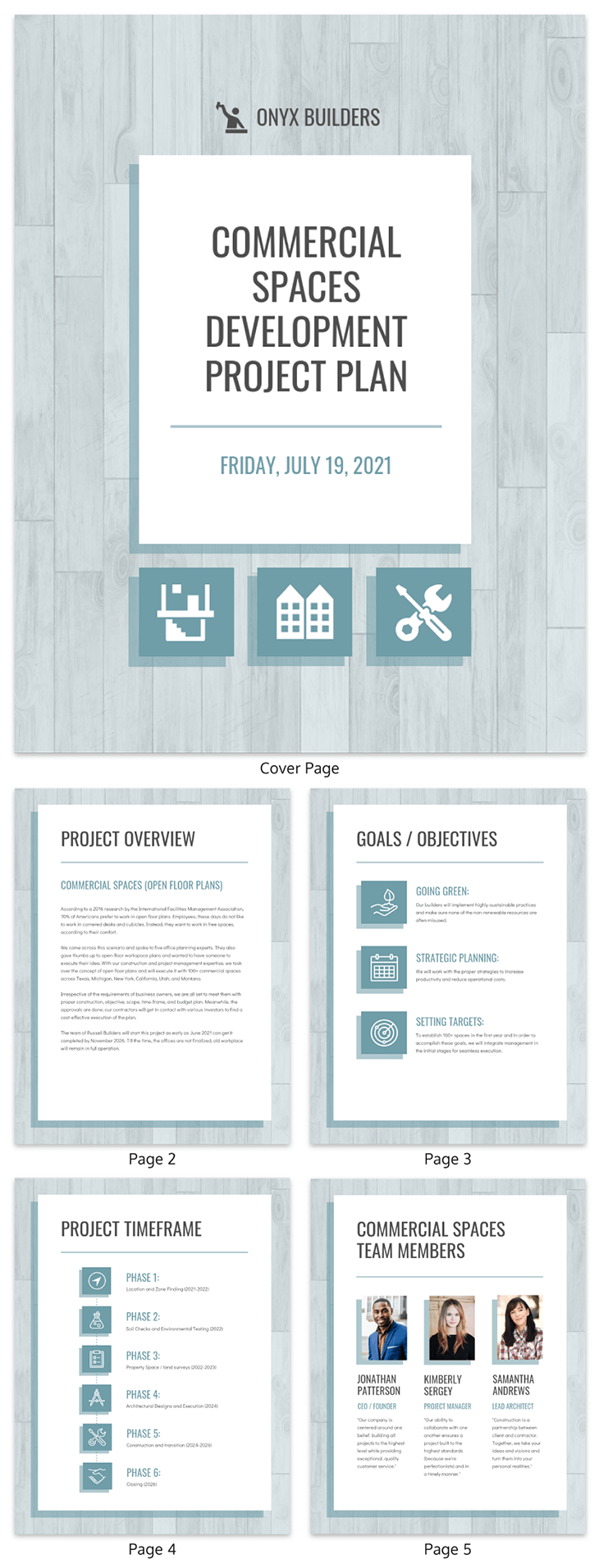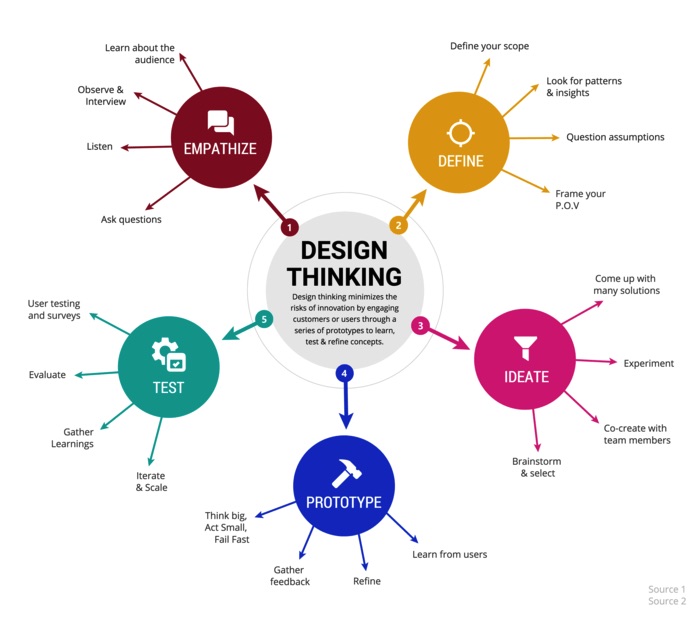Best of PMTimes: Project Success – 7 Steps For Building Projects That Deliver Results
Project success is achievable—but you need the right mindset and tools to make it happen.
Whether your project is big or small, the guide below will help you create a project plan, define your goals, learn to communicate with your team and find the right tools for success.
1. Plan For Project Success
Creating a project plan is the first step in achieving project success—it also saves on resources, time, and effort.
A project plan is a document that can be used for internal and external purposes—it outlines the scope, deadlines, budgets, and approximate resources required for a project.
Write the project plan before implementation begins—this will give your team direction to achieve their goals.
For inspiration, look at the project template below. It outlines how a construction company will be building a new development, with details about the phases of the project.

Source: Venngage
Note how the plan includes an overview of the project, statistics about open floor plans, and their methodology for working out their chosen layouts.
It also outlines goals and objectives for the project, along with deadlines, thus ensuring that everyone involved—team members and clients—are on the same wavelength.
Your project plan can also include an executive summary where you share information about your company, and how you relate to the project.
A risk plan is a good inclusion—you don’t need to include too many details but let your client know what could go wrong and how you would handle it.
2. Goal Setting For Project Success
The success of a project depends on goal-setting—more nuanced and relevant goals help you deliver results that will please clients.
Use the SMART goal-setting system to plan out the direction of your project:
- Specific: Project goals should be specific—build X number of properties, or generate X amount of revenue—so teams can aim for something concrete.
- Measurable: When you create specific goals, it becomes easier to measure the success or failure of a project—and to determine what needs improvement.
- Attainable: Clients want to go big with their goals—and it can be tempting to go along with them. But if your goals are too ambitious, you will fail to achieve them. Worse, you could stretch your team too far and fail to complete the project by the deadline.
- Relevant: The goals you set need to be relevant to the vision of your project and the abilities of your team. That is what will make the goals achievable.
- Timely: Creating timelines for your project’s goals ensures success. Give your team enough time to complete elements of the operation so you can deliver results to your client on time.
With your core goals in place, you will be able to plan out your project and give your clients a realistic idea of what will be completed and by when.
3. Mind Maps For Effective Project Management
A mind map is an excellent tool for achieving project success—especially during the planning stage when you are outlining the goals.
Use a mind map to generate and narrow down ideas—this is a process that can be conducted within the project team as well as with relevant stakeholders.
Look at this strategy mind map for a design-based project—it defines the process for developing a new service and uses a numbered system identifying the steps involved.

Source: Venngage
The key to creating a mind map is to settle on one core idea from which you can expand your strategy.
Visualizing the idea makes it easier to examine—you use multiple faculties to study the concept, which generates more critical thinking.
When designing a mind map, use a few colors to code the divisions in ideas, processes, or project steps. This will make absorbing the concept easier for everyone involved.
When presenting the project plan and mind map to external stakeholders, brand it with your logo and brand colors to make your business stand out.
4. Enlist Project Managers
Companies would do well to hire project managers if they want to deliver successful projects.
There are certain aspects of project execution that can be handled in-house, but project management requires specialized skills.
Successful project managers have excellent leadership skills, which are required no matter the size of the project.
As overseers of the operation, they direct the team forward without pushing anyone to do too much, and keep track of deadlines.
Managers also have strong communication skills—they speak with team members, suppliers, brokers, stakeholders, and clients.
Projects have many hands on deck—and everyone has their specific demands. Negotiating peace between the departments is a specialized skill that not everyone has.
In-house staff members have the qualities outlined above, but they also have their day jobs. Expecting them to take on project management as an addition would be unfair.
Advertisement
[widget id=”custom_html-68″]
That is why companies should hire a project manager for the task.
5. Agile Project Planning
The agile approach to project success prioritizes people and collaboration, while also acknowledging the importance of software.
Project agility includes these tenets:
- Creating a motivational environment for project teams
- Encouraging innovation and autonomy
- Delivering customer satisfaction using project tools
- Adaptability to changes
- Team collaboration
- Regular communication
- Measuring success and failure
Agile project management is focused on delivering excellent results, as well as on building sustainable environments that are long-lasting.
Use the same guidelines across multiple projects and years—improving along the way, depending on what teams have learned—to achieve a high standard of results.
This method also mitigates a lot of the risks that come with project planning—changing goals and supplies are built into the system.
More importantly, the agile system helps create autonomous teams who innovate, experiment and learn, thus making them efficient and happy.
6. Communication Is Key For Project Success
There are numerous moving parts in projects, so prioritize communication to achieve project success.
Create a workflow and feedback plan—outline tools or services teams need to use.
Remember that communication can’t be one-way only—if you aren’t listening to team members or employees, you won’t know why they are struggling with tasks.
Be open to feedback by using team chat tools like Chanty, Slack, or Skype. If training is required, build time into your project plan for this process.
While communication is necessary, too many meetings can get disruptive—set a meeting schedule that everyone can plan their day around.
7. Tools For Project Success
The right tools and software make it easier to achieve project success—they improve workflow by sharing instant notifications for any developments.
Use a tool like JIRA to manage projects and Trello for task management. You can use remote work tools like Proofhub or Basecamp.
These tools help to collaborate and keep track of resources, budgets, and project progression.
They also have provisions to set deadlines so you can improve productivity. More importantly, this software helps to avoid overlaps in tasks, missed deadlines, and gaps in communication.
Key Takeaways: Project Success Is Achievable
We have outlined seven essential steps for achieving project success, no matter the size of the operation at hand.
To recap, here are the key takeaways from the above guide:
- Create a project plan for success
- Set your project goals
- Use mind mapping to strategize
- Invest in project managers
- Be agile in your project management
- Keep communication lines open
- Invest in the right tools
With the above steps, you have the wherewithal to build a project that delivers results to your clients.




